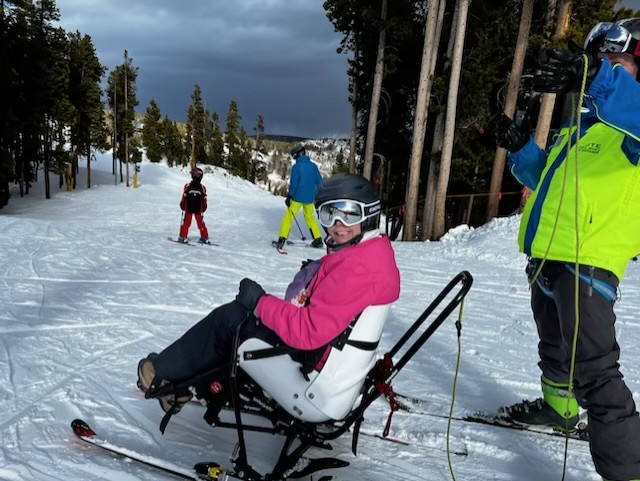
Last month, I got to go skiing at Eldora with Ignite Adaptive Sports.
I skied a lot growing up. When I was five, my dad tied a rope around my waist and sent me down the mountain. That’s when I became a speed demon. Eventually, I had proper lessons so I could race down ski runs with confidence.
Once I became disabled, skiing became impossible. Or so I thought. Ignite Adaptive Sports has made it possible for me to ski again.
Founded in 1975, Ignite started with a group of CU Boulder students who wanted to help people with disabilities to enjoy the outdoors. Fifty years later, Ignite has 336 volunteers and just three full-time staff.
Last season, Ignite provided 1,327 lessons to 366 athletes. According to Kevin Wilson, Ignite’s program manager, volunteers provide over $600,000 worth of support annually.
“I would not be able to raise enough money to provide the staffing support our volunteers do,” said Kevin Wilson, Ignite’s program manager.
This season is Ignite’s first in the new Caribou Lodge, where the organization has the entire first floor. The lodge has easy access to the Bunny Hill (actual name: Uncle Bob’s) and the Magic Carpet beginner lift (Tenderfood). Before the lodge, Ignite operated out of a trailer!
On my first day with Ignite, I used a bi-ski. I sat in a contraption called a boot, which sat on top of two skis. Outriggers attached to my forearms, enabling me to steer my boot down the mountain.
My seat was called the bucket. It has a handle on the back so an instructor could hold on to me to help me balance. As the student progresses, the instructor can use tethers to give the student freedom to steer and balance on their own.

I tried another device in my second lesson called a SnowKart. I loved the ski cart, because it’s more stable and doesn’t require you to balance — which meant I could go faster. (Regular readers of this column will remember from my report on adaptive water skiing that I like to go fast.)
The ski cart is like a go-cart on skis. Steering is controlled by levers attached to skis. On the bi ski, the skier steers by pushing down on the outriggers and leaning. It’s difficult to build speed before falling over. This doesn’t happen on the ski cart.
For me, the ski cart gave me a closer experience to actual skiing.
Students can choose half- or full-day lessons. Equipment and a lift ticket are provided. I paid $95 for a half-day lesson — $95 for two instructors (the number of instructors is determined by the athlete’s need), equipment and a lift ticket is a great deal.
Ignite even has options for quadriplegic skiers: the TetraSki, a cart that can be controlled with a joystick or a puff-and-blow, allowing skiers to steer using their mouth. The Denver School for the Blind includes Ignite skiing, snowboarding and snowshoeing into their yearly curriculum.
The equipment is state-of-the-art; Ignite works with college students trying out new designs. The TetraSki was originally a SnowKart; students from the University of Utah reconfigured it and added electronics, Wilson said.
My two January trips to Eldora were the first time I’d skied in over 15 years; the first time since becoming a wheelchair user. As a person with disabilities, I’m so thankful for programs like Ignite.
Jenn Ochs lives in Boulder and enjoys listening to music, podcasts and audiobooks while painting or drawing. She is a disability rights advocate and a graduate from Baylor University in Texas, which is where she realized that Boulder is the best place to live.
Want to help? Ignite is looking for volunteers. Visit igniteadaptivesports.org to learn more.
